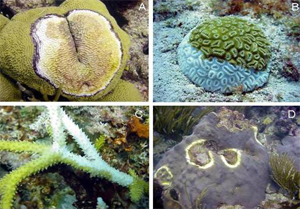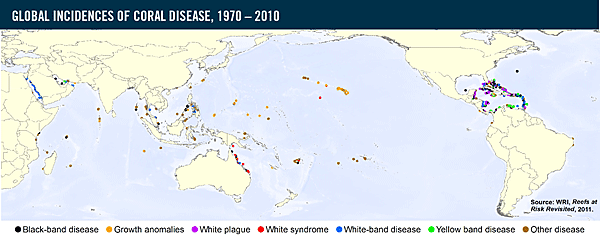Disease Impacts

Common coral diseases in the Caribbean. (A) Pseudodiploria strigosa with black band disease, (B) Dichocoenia stokesii with white plague, (C) Acropora cervicornis with white band and (D) Orbicella faveolata with yellow blotch syndrome. Photos © E. Weil, from NOAA’s Center for Coastal Monitoring and Assessment
Coral disease outbreaks can lead to an overall reduction in live coral cover and reduced colony density. In extreme cases, disease outbreaks can initiate community phase-shifts from coral- to algal-dominated communities. Coral diseases can also result in a restructuring of coral populations: for example, a shift from long-lived, slow-growing massive reef builders to communities dominated by smaller, shorter-lived corals. ref
Coral disease also may cause significant changes in reproduction rates, growth rates, community structure, species diversity, and abundance of reef-associated organisms. ref
Global Patterns
Coral diseases are distributed globally. The following map shows where some of the major diseases are located.

This map illustrates the locations of some of the major diseases facing coral reefs. The “Other disease” category includes skeletal eroding band, brown band, atramentous necrosis, trematodiasis, ulcerative white spots, and other syndromes that are poorly described. Click to enlarge. Source: WRI Reefs at Risk 2011
The Caribbean has been referred to as a “hot spot” for coral disease because of a rapid emergence of new and extremely virulent diseases, increased frequency of events, and rapid spread of emerging diseases among new species and regions. ref Although only 8% of all coral reefs (by area) are found in the Caribbean, over 70% of all disease reports come from this region. ref Furthermore, at least 82% of coral species in the Caribbean are host to at least one disease. ref
A number of studies indicate that disease prevalence in the Indo-Pacific region, American Samoa ref and Hawai‘i ref is currently quite low. However, across the Indo-Pacific region, diseases appear to be exhibiting a rapid expansion in range and types of disease since 2000. ref As efforts increase to document coral diseases globally, the lists of species affected by disease, locations where diseases are reported, and prevalence of those diseases, are steadily increasing.
